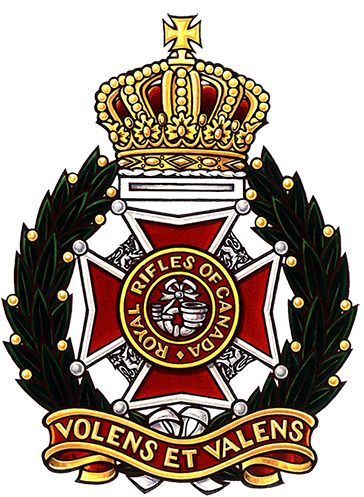Royal Rifles of Canada
The official lineage of Royal Rifles of Canada infantry regiment.

Badge
Description
On a Maltese cross Gules edged pommé and angled of lions passant Argent, a torteau charged with a bugle stringed Argent encircled by an annulus Gules edged and inscribed ROYAL RIFLES OF CANADA in letters Or, the whole within a wreath of laurel Vert issuant from a scroll Gules edged and inscribed with the Motto in letters Or, and ensigned by the crown of His Royal Highness the Prince Consort proper set on a tablet Argent.
Symbolism
The Maltese cross, which is based on the insignia of the Royal Guelphic Order, and the bugle, are common among badges of light infantry and rifle regiments. The laurel wreath, which symbolizes excellence and achievement, has its roots since Ancient Greece in competition or combat. The crown worn by Prince Albert, the husband of Queen Victoria, of a style used by the Princes of the Holy Roman Empire, represents service to the Sovereign.
Motto
VOLENS ET VALENS (Willing and capable)
Marches
Quick March
"I'm Ninety Five"
Double Past
Money Musk
Regimental colour
Rifle regiments do not carry Colours. They may emblazon their battle honours on unit appointments such as cap badges.
Camp flag
No camp flag authorised.
Battle honours
South African War
SOUTH AFRICA, 1899-1900.
The First World War
YPRES, 1915, '17; FESTUBERT, 1915; MOUNT SORREL; SOMME, 1916; ARRAS, 1917; HILL 70; AMIENS.
The Second World War
Hong Kong; SOUTH-EAST ASIA, 1941.
Lineage
This Reserve Force regiment originated in Quebec City, Quebec on 28 February 1862, when 'The 8th Battalion Volunteer Militia Rifles, Canada' was authorized to be formed.Footnote 1 It was redesignated: '8th or Stadacona Volunteer Militia Rifles' on 28 March 1862;Footnote 2 '8th Battalion "Royal Rifles"' on 6 April 1877;Footnote 3 '8th Regiment "Royal Rifles"' on 8 May 1900;Footnote 4 'The Royal Rifles of Canada' on 29 March 1920;Footnote 5 '2nd (Reserve) Battalion, The Royal Rifles of Canada' on 7 November 1940;Footnote 6 and 'The Royal Rifles of Canada' on 1 June 1945.Footnote 7 On 22 February 1965, it was amalgamated with 'Les Voltigeurs de Québec'.Footnote 8 On 1 November 1966, these two regiments ceased to be amalgamated and the regiment was reduced to nil strength and transferred to the Supplementary Order of Battle.Footnote 9
Notes:
Notes:
Upon redesignation as The Royal Rifles of Canada on 29 March 1920 (see above), it was organized as a two battalion regiment with the 1st Battalion (171st Battalion, CEF) on the Non Permanent Active Militia order of battle, and the 2nd Battalion (no CEF designation) on the Reserve order of battle.
The Royal Rifles of Canada were disbanded for the purpose of reorganization on 1 October 1920 and reorganized the same day (GO 232/20). This change was administrative and does not affect the lineage of the regiment.
On 1 November 1929, the battalions were redesignated the 1st Battalion (12th Battalion, CEF) and 2nd Battalion (171st Battalion, CEF) (GO 138/29). The reserve unit was disbanded on 14 December 1936 (GO 3/37).
Perpetuations
'12th' and '171st "Overseas" Battalion(s), CEF'
Headquarters Location
Quebec City, Quebec
Operational history
The Fenian Raids
The 8th Volunteer Militia Rifles were called out on active service on 8 March 1866. The battalion, which served in Quebec City, was removed from active service on 31 March 1866.Footnote 10
South African War
The regiment contributed volunteers for the Canadian contingents in the field, mainly the « 2nd (Special Service) Battalion, Royal Canadian Regiment of Infantry ».Footnote 11
The First World War
Details of the regiment were placed on active service on 6 August 1914 for local protection duties.Footnote 12
The 12th Battalion, which was authorized on 10 August 1914 as the '12th Battalion, CEF',Footnote 13 embarked for Great Britain on 30 September 1914.Footnote 14 It was redesignated '12th Reserve Infantry Battalion, CEF' on 29 April 1915, to provide reinforcements for the Canadian Corps in the field.Footnote 15 The battalion was disbanded on 15 September 1920.Footnote 16
The 171st Battalion, which was authorized on 15 July 1916 as the '171st "Overseas" Battalion, CEF',Footnote 17 embarked for Great Britain on 24 November 1916.Footnote 18 Its personnel were absorbed by the '20th Reserve Battalion, CEF' on 8 January 1917 to provide reinforcements to the Canadian Corps in the field.Footnote 19 The battalion was disbanded on 27 July 1917.Footnote 20
The Second World War
Details from the regiment were called out on service on 26 August 1939 and then placed on active service on 1 September 1939, under the designation 'The Royal Rifles of Canada, CASF (Details)', for local protection duties.Footnote 21 The details called out on active service were disbanded on 31 December 1940.Footnote 22 Details of the regiment were again called out on service on 1 January 1941, under the designation 'Details of 2nd (Reserve) Battalion, The Royal Rifles of Canada'.Footnote 23 The details were removed from active service on 30 September 1941.Footnote 24 The regiment subsequently mobilized 'The Royal Rifles of Canada, CASF' for active service on 24 May 1940.Footnote 25 It was redesignated '1st Battalion, The Royal Rifles of Canada, CASF' on 7 November 1940.Footnote 26 The battalion served in Newfoundland on garrison duty from early November 1940 to August 1941.Footnote 27 On 27 October 1941 it embarked for Hong Kong, where it was destroyed while fighting in defence of the colony.Footnote 28 The unit was reconstituted on 10 January 1942.Footnote 29 It served in Canada in a home defence role as part of the Vancouver Defences of Pacific Command.Footnote 30 On 2 January 1945 it embarked for Great Britain,Footnote 31 where it was disbanded on 10 January 1945 to provide reinforcements to the Canadian army in the field.Footnote 32